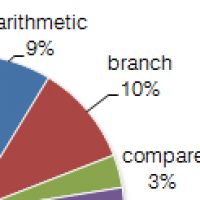 PowerPC (Performance Optimization With Enhanced RISC - Performance Computing) or PPC is totally unrelated to the Intel x86-based PC that most of us know. The Power PC is a RISC instruction set architecture created by the 1991 Apple-IBM-Motorola alliance, known as AIM PowerPC. This becomes instantly obvious to anyone examining the assembly level language. It is, at first sight, somewhat quirky; most assembler programmers can swiftly move from one CPU to another fairly rapidly, the PPC however requires a little more effort.
PowerPC (Performance Optimization With Enhanced RISC - Performance Computing) or PPC is totally unrelated to the Intel x86-based PC that most of us know. The Power PC is a RISC instruction set architecture created by the 1991 Apple-IBM-Motorola alliance, known as AIM PowerPC. This becomes instantly obvious to anyone examining the assembly level language. It is, at first sight, somewhat quirky; most assembler programmers can swiftly move from one CPU to another fairly rapidly, the PPC however requires a little more effort.
The PPC has several novel features, such as seven independent condition register sets (each set contains flags for less than, greater than, equal and overflow). These condition register sets are explicitly specified when performing comparisons, meaning that the compares and branches can be distributed throughout code in a way that could be somewhat unintuitive. One instruction that took some time to get to grips with was the ISEL instruction. This makes use of the condition register set and allows conditional execution while eliminating branch instruction.
cmplw %cr7, %r9, %r5
Compare register 9 with register 5 and set the appropriate bits in condition register 7.
So now we can look at the isel instruction. It is defined in the PPC manual as:
Integer Select -
isel rD,rA,rB,crb
If CR[crb] is set, the contents of rA (or the immediate value 0) are copied into rD. If CR[crb] is clear, the contents of rB are copied into rD
crb is an integer corresponding to the specific flag within the condition register of interest. Values of crb are as follows:
| Condition Register | LT | GT | EQ | V |
|---|---|---|---|---|
| CR0 | 0 | 1 | 2 | 3 |
| CR1 | 4 | 5 | 6 | 7 |
| CR2 | 8 | 9 | 10 | 11 |
| CR3 | 12 | 13 | 14 | 15 |
| CR4 | 16 | 17 | 18 | 19 |
| CR5 | 20 | 21 | 22 | 23 |
| CR6 | 24 | 25 | 26 | 27 |
| CR7 | 28 | 29 | 30 | 31 |
Why should this interest us? There are two reasons that this instruction is relevant to us:
- For minimizing both worst-case execution time, and execution jitter, it is better to avoid branches in code wherever possible
- Code complexity metrics suggest that the complexity of a piece of code and it's liability to failure is often directly related to the number of branches in the code.
So, if we re-write the following code:
cmpwi %cr7,%r11,35 beq cr7, Label1 ; branch if r11 == 35 li %r0,0 ; else set r0 = 0 b Label2 Label1: li %r0,1 ; set r0 = 1 Label2:
Using the isel instruction:
li %r10,0 li %r5,1 , cmpwi %cr7,%r11,35 isel %r0,%r5,%r10,30
This rewriting gives us only one less instruction - but that's 20% of this fragment, and it now contains no branches or labels!
Only one possible path exists in this fragment instead of two, which means that the execution time of this fragment is now deterministic.
The application of this technique to the entire code base can make a significant reduction in effort and complexity when performing and coverage code analysis.
This is just one feature of the PPC architecture. Watch this space for more snippets!

 Rapita System Announces New Distribution Partnership with COONTEC
Rapita System Announces New Distribution Partnership with COONTEC
 Rapita partners with Asterios Technologies to deliver solutions in multicore certification
Rapita partners with Asterios Technologies to deliver solutions in multicore certification
 SAIF Autonomy to use RVS to verify their groundbreaking AI platform
SAIF Autonomy to use RVS to verify their groundbreaking AI platform
 What does AMACC Rev B mean for multicore certification?
What does AMACC Rev B mean for multicore certification?
 How emulation can reduce avionics verification costs: Sim68020
How emulation can reduce avionics verification costs: Sim68020
 Multicore timing analysis: to instrument or not to instrument
Multicore timing analysis: to instrument or not to instrument
 How to certify multicore processors - what is everyone asking?
How to certify multicore processors - what is everyone asking?
 Certifying Unmanned Aircraft Systems
Certifying Unmanned Aircraft Systems
 DO-278A Guidance: Introduction to RTCA DO-278 approval
DO-278A Guidance: Introduction to RTCA DO-278 approval
 ISO 26262
ISO 26262
 Data Coupling & Control Coupling
Data Coupling & Control Coupling
 DASC 2025
DASC 2025
 DO-178C Multicore In-person Training (Fort Worth, TX)
DO-178C Multicore In-person Training (Fort Worth, TX)
 DO-178C Multicore In-person Training (Toulouse)
DO-178C Multicore In-person Training (Toulouse)
 HISC 2025
HISC 2025


















